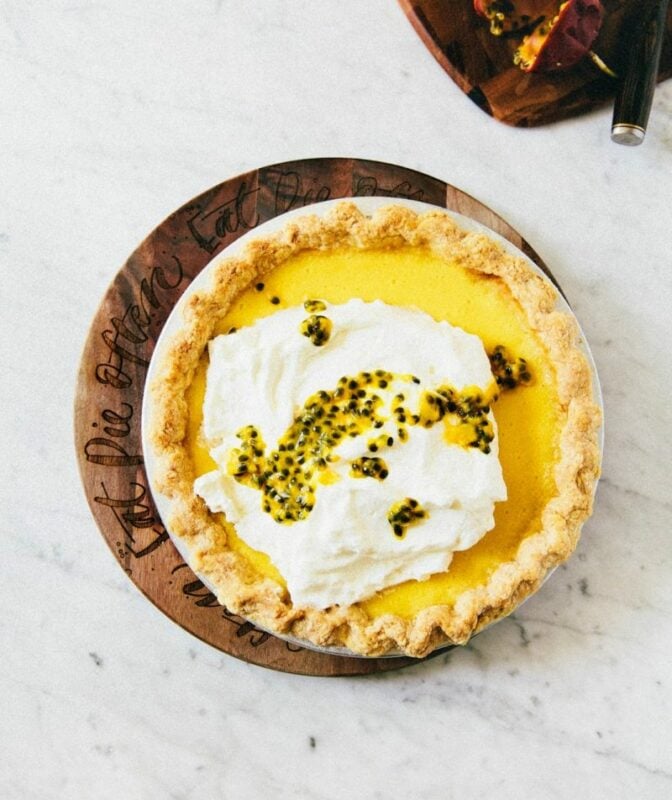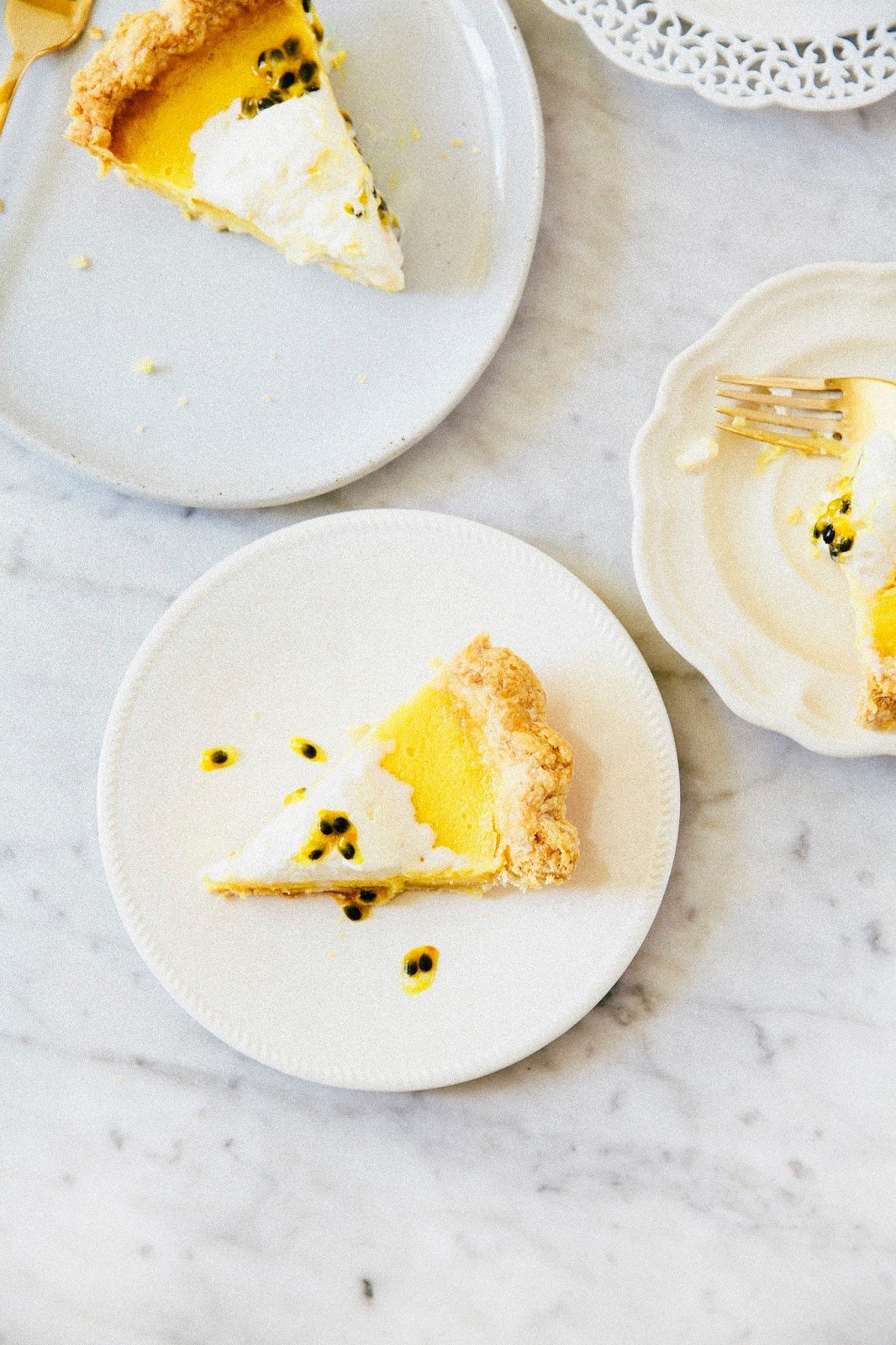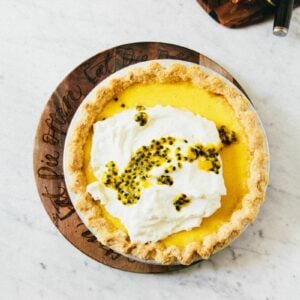Guys, I got cocky.
After the triumph that was last month’s epic #pieamonth pear and creme fraiche caramel pie, I thought I had it.
I’m a pie expert now! I thought to myself a few weeks ago, as I woke up early to create my next #pieamonth pie. This is going to be a breeze. It doesn’t even have a lattice! I’m just going to do as I do — roll out my pie, stick it in the freezer, prep the filling — and go grab a pastry with Jessica. By the time I’m back, it’ll be ready for the oven.
One chocolate ganache kouign amann and crazy delicious violet cheesecake later, I stuck the beautifully rolled and perfectly crimped frozen crust to pre-bake in the oven.
Pre-baking is often required when baking a custard or curd pie — the moisture in the filling can make the crust soggy before it has time to actually bake. The point of pre-baking it beforehand without any filling is to give the crust a head start to bake and ultimately solidify before the filling, helping the crust stay firm and prevent soggy bottomed crusts. However, you can’t just bake the pie shell without weight to hold it down in the middle — as the crust bakes, pockets of steam get created within the pastry that cause it to puff up and ultimately sag around the edges. You need that weight to hold it down, which is why most pre-baking recipes instruct you to line your shell with aluminum foil or parchment paper filled with pie weights.
So I was placing my beautifully rolled, crimped, lined, and weighted pie in the oven, the parchment paper holding my pie weights gently brushed my countertop oven’s heat source and burst into flame.
Have you ever seen parchment paper catch on fire? Especially the cheap kind you can buy in bulk on Amazon that’s so thin and tissue papery that you often need to use two or three sheets at a time?
Well, it burns up like gangbusters.
My cat watched in judgement as I screamed, dropped the pan containing the pie, and hastily picked up the flaming inferno formerly known as my parchment paper and lobbed it into my sink. Hundreds of ceramic pie weights flew across the kitchen, making a racket as they bounced across the kitchen floor and rolled to irretrievable places underneath the oven and refrigerator.
I turned to see if my beautifully prepared shell was salvageable. NOPE. I found it lying face down on the ground in a pretty sorry state: half-melted on one side, covered in bits of ash and floor lint.
And that, my friends, is what happens when you get cocky when making pie.
Some baker’s notes:
-
- You can use either fresh passionfruit juice (with the seeds strained out) or frozen passionfruit puree in this recipe. Fresh passionfruit was a little hard for me to source, but I would occasionally (and rather randomly) see it at major supermarkets like Whole Foods and even Safeway. You can also use passionfruit puree, which can be found in the frozen section of Latin American markets or even online (but for a much steeper price). Whatever you do though, don’t use artificial/shelf-stable passionfruit juice. They put a ton of extra sweetener and artificial preservatives in there that’ll just ruin your curd.
- I’ve already explained pre-baking science, so I won’t repeat myself here. One word of advice though — if you have a small oven similar to mine, perhaps use a non flammable material like aluminum foil to line your pie instead. You also don’t need to use fancy ceramic pie weights — you can use rice, beans, or even coins! Just make sure you use a generous amount of weight; if you don’t use enough, the crust sags in the middle and destroys your beautiful crimp. Which is what happened to me the second time I made this pie.
Get the Recipe: Passionfruit Curd Pie
Ingredients
For the Lard and Butter Pie Crust
(makes one 9-inch, single crust pie)
- 1 cup very cold water
- 1/2 cup ice
- 2 tablespoons apple cider vinegar
- 1 1/4 cups (6.25 ounces) all-purpose flour
- 1 teaspoon granulated sugar
- 1/2 teaspoon kosher salt
- 1/4 cup (1/2 stick // 2 ounces) very cold unsalted butter, cut into 1-inch cubes
- 1/4 cup (2 ounces) very cold rendered leaf lard, cut into 1/2-inch pieces
For the Passionfruit Curd
(makes enough for one 9-inch pie)
- 1 cup (7 ounces) granulated sugar
- 1 tablespoon cornstarch
- 1/4 teaspoon kosher salt
- 6 large eggs
- 2/3 cup (5.35 fluid ounces) passionfruit puree
- 1/2 cup (1 stick // 4 ounces) unsalted butter, at room temperature and cut into 1-inch cubes
- 1/2 teaspoon pure vanilla extract
For the Crème Fraîche Whipped Cream
(makes around 1 cup)
- 1/2 cup (4 fluid ounces) very cold heavy whipping cream
- 1/4 cup (2 ounces) crème fraîche
Equipment
- a 13 x 13-inch square made from aluminum foil
- ceramic pie weights (see baker’s notes for substitutions)
- a candy thermometer (preferably digital — I love this one)
Instructions
For the Lard and Butter Pie Crust
- Combine 1 cup water, 1/2 cup ice, and 2 tablespoons apple cider vinegar in a liquid measuring cup and give it a brief mix with a whisk or fork to combine the ingredients. Transfer to the refrigerator to chill and keep cold while you bring the dry ingredients together.
- In a medium bowl, whisk together 1 1/4 cups all-purpose flour, 1 teaspoon granulated sugar, and 1/2 teaspoon kosher salt until combined. Add 1/4 cup unsalted butter and 1/4 cup lard and coat with the flour mixture using your hands by gently tossing the mixture over the pieces (but don't actually touch the butter and lard pieces themselves — you don't want them to get melty!). Working quickly, use a pastry blender to cut the butter and lard into the flour mixture until mostly pea-sized pieces of the butter and lard remain.
- Remove the ice water mixture (from the 1st step) from the refrigerator and sprinkle 2 tablespoons of the ice water mixture over the flour mixture. Mix and cut in the water with the pastry blender until it is fully incorporated. Add more of the ice water mixture, 1 to 2 tablespoons at a time, and mix until the dough comes together in a ball with some dry bits remaining. Squeeze and pinch with your fingertips to bring all the dough together, sprinkling any dry bits with more small drops of ice water if necessary to combine. Be careful during this part — don’t use too much water or you’ll end up with a soggy pie crust and I’ll cry for you! Use only the amount needed to bring the dough together into a ball; you’ll likely only use about half of the ice water mixture, if that.
- Shape the dough into a flat disc, wrap in plastic, and refrigerate for at least 1 hour, preferably overnight before rolling, crimping, and ultimately pre-baking.
To Pre-Bake the Pie Crust
- First, prepare the crust. Once the dough has chilled overnight and has the texture and consistency of saltwater taffy, it’s ready to be rolled. Liberally sprinkle a work surface with flour. Unwrap the dough and place it on the work surface, sprinkling its top with flour. If the dough is hard, let it rest for a few minutes. If the dough seems too sticky at first, add flour liberally. Use a rolling pin to roll with light pressure, from the center out, moving the pie dough around every quarter to roll it evenly. Roll the the dough to about 12 to 13 inches in diameter and about 1/4 inch thick (place your pie plate upside down over it to check its size).
- Move the dough into the pie plate by folding it into quarters, then moving it into the plate and unfolding it. When the dough is in the plate, press it firmly into the bottom and sides of the plate. Roll the excessive pie dough overhang so that it sits like a tube on the pie plate rim. At this point, you can either crimp the tube with a fork or use your fingers to create a crimping pattern (The New York Times has a great how-to video demonstrating a relatively easy crimping technique). Once you've styled the crust, poke the sides and bottom of the pie crust all over with a fork to create holes — these holes allow steam to escape and help keep the pie crust in shape when pre-baking. Cover loosely with plastic wrap and freeze for at least 1 hour until firm.
- When the crust has frozen and you're ready to bake it, center a rack in the oven and preheat to 350 (F). Remove the pie crust from the freezer and place the 13 x 13-inch square of aluminum foil over the pie crust, gently smoothing it into place and pleating it as needed to fit foil up against the bottom and sides of the shell. Fill the shell to the top with your pie weights. Gently stir the weights around with your fingers to ensure there are no air pockets, especially down in the corners where the sides and bottom of the pan meet.
- Place the weighted pie crust on a baking sheet and bake in the preheated oven for 25 minutes, until the crimped edges have started to brown. Remove the pie and baking sheet from the oven and place on a wire rack; gently lift out the aluminum foil containing the weights. Transfer the pie back to the oven and bake for another additional 10 minutes, until the bottom and crimped edges of the pie are golden brown. Turn out to a wire rack to cool completely to room temperature. Do not fill the pie if the crust is still warm — you'll end up with a soggy crust if you do!
For the Passionfruit Curd Pie
- Once the pre-baked pie has cooled to room temperature completely, center a rack in the oven and preheat to 350 (F). Set the pre-baked pie crust on a baking sheet.
- In a medium, heavy bottomed saucepan, whisk together 1 cup granulated sugar, 1 tablespoon cornstarch, and 1/4 teaspoon kosher salt until combined. Whisk in 6 large eggs until incorporated. Add 2/3 cup passionfruit puree and whisk until the mixture is a homogenous, sunny yellow.
- Fit a candy thermometer to the side of the pan and place the pan over medium heat. Cook the mixture, whisking constantly to prevent it from curdling, until the mixture thickens up, lightens in color, and registers 160 (F) on the candy thermometer; this should take around 10 minutes.
- Remove the pan from the heat and add 1/2 cup unsalted butter one cube at a time, whisking until the mixture is smooth and all the butter has fully incorporated. Whisk in 1/2 teaspoon pure vanilla extract.
- Pour the passionfruit curd into the pre-baked pie shell and bake in the preheated oven for 20 to 25 minutes, until the edges of the filling have puffed but the center is barely set. You can test this by giving the baking sheet a jolt in the oven — the center should still wobble slightly when you pull it out. If it’s pretty solid, you’ve overcooked it!
- When the pie has finished baking, transfer to a wire rack to cool completely to room temperature, before chilling in the refrigerator overnight before slicing and serving with the crème fraîche whipped cream.
For the Crème Fraîche Whipped Cream
- When the pie has chilled and you're ready to serve it, make the crème fraîche whipped cream. In a freestanding electric mixer fitted with a whisk attachment, whip 1/2 cup heavy whipping cream until soft peaks form. When soft peaks form, fold in 1/4 cup crème fraîche until fully incorporated. Use immediately.











This is a fabulous recipe and dessert! It came out just perfect, I followed the recipe to the teeth!! Thank you for sharing🤗
Can I use a jar of passion fruit curd? If so, do I still need to bake the pie?